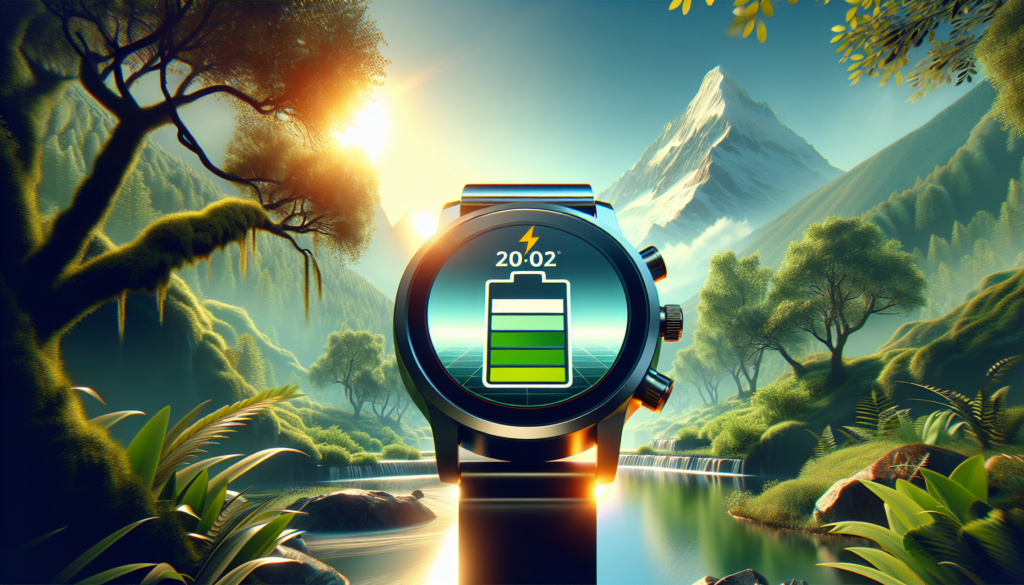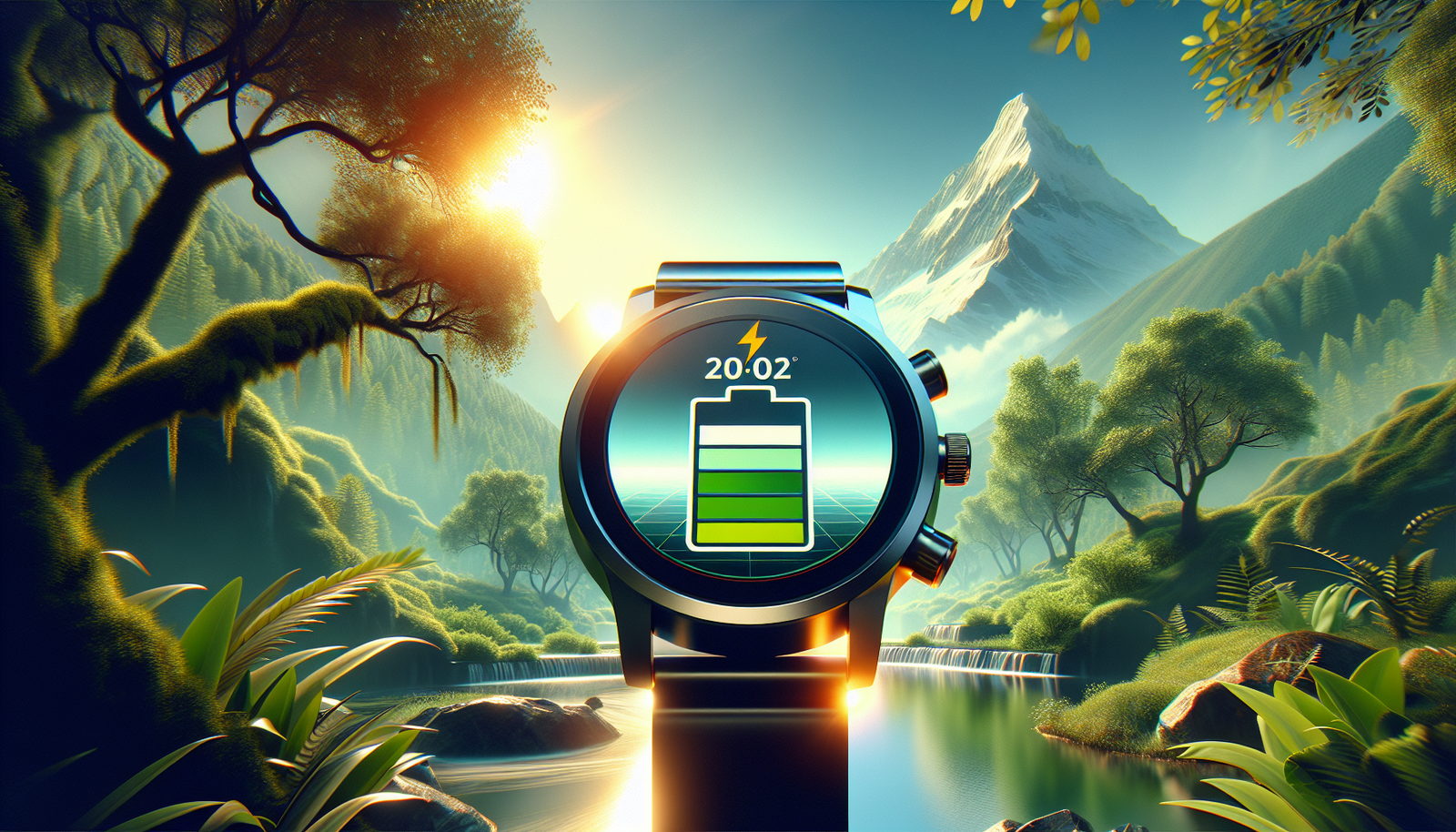If you’ve ever owned a smartwatch, you know the frustration of constantly having to charge it. The convenience and functionality it provides can easily be overshadowed by its short battery life. But fear not, because in this ultimate guide, you will discover a treasure trove of tips and tricks to maximize your smartwatch battery life. From adjusting settings to managing notifications, we’ll help you unlock the full potential of your device while ensuring it lasts all day and beyond. So say goodbye to constant charging and hello to a smarter, longer-lasting companion on your wrist.
Choosing the Right Smartwatch
When it comes to choosing the right smartwatch, one of the most important factors to consider is the battery capacity. A smartwatch with a larger battery capacity will generally last longer throughout the day, allowing you to use it for a longer period of time before needing to recharge.
In addition to the battery capacity, it’s also essential to check for power-saving features in a smartwatch. Some smartwatches come with features like automatic screen brightness adjustment, GPS power optimization, and activity tracking optimizations, which can help extend the battery life considerably.
Another crucial aspect to consider is the efficiency of the operating system. Some operating systems are more optimized for power usage, allowing the smartwatch to run smoothly without draining the battery quickly. It’s worth doing some research and reading reviews to see which operating system is known for its efficiency and can help maximize the battery life of a smartwatch.
Optimizing Smartwatch Battery Life
Once you have chosen and purchased your ideal smartwatch, it’s time to optimize its settings for better battery life. There are several settings you can adjust to ensure that your smartwatch lasts throughout the day without needing frequent charging.
One of the first settings to adjust is the screen brightness. Lowering the brightness level on your smartwatch not only helps conserve battery power but also makes it easier on the eyes in darker environments. Finding a balance between brightness and readability is key to maximizing the battery life of your smartwatch.
Enabling the power-saving mode on your smartwatch can also greatly enhance the battery life. In power-saving mode, certain features and functionalities may be restricted or limited, but it helps prioritize battery conservation. It’s a useful option to consider when you know you won’t have access to a charger for an extended period.
Managing notifications is another crucial step in optimizing your smartwatch settings. By selecting which apps can send notifications to your smartwatch, you can minimize unnecessary distractions and conserve battery power. Disabling notifications from less important or rarely used apps can significantly improve battery life.
Additionally, disabling the always-on display feature, if available, can help conserve battery power. With this feature turned off, your smartwatch’s screen will only light up when you lift your wrist or interact with it, saving precious battery life throughout the day.

Managing App Usage
To further maximize the battery life of your smartwatch, it’s essential to manage the usage of apps installed on it. Uninstalling unnecessary apps that you rarely or never use not only frees up storage space but also reduces the strain on the battery. So take the time to go through your apps and remove the ones that you no longer need.
Limiting background app refresh is another effective way to optimize your smartwatch’s battery usage. Background app refresh allows apps to update their content and data even when they are not actively in use. By disabling or minimizing this feature for non-essential apps, you can conserve battery power by preventing unnecessary background tasks from running.
Closing background apps that are not in use is also crucial in maximizing the battery life of your smartwatch. Keeping too many apps open in the background can consume considerable battery power. So make it a habit to close apps that you are not actively using to ensure optimal battery performance.
Using Watch Faces Wisely
The watch face of your smartwatch not only adds a personal touch but can also impact its battery life. Opting for minimalistic watch faces with simple designs and fewer complications can significantly reduce the strain on the battery. Fancy and feature-rich watch faces with live animations or constantly changing elements tend to consume more power, leading to shorter battery life.
Another tip for maximizing battery life is to use dark-colored watch faces. Smartwatches with OLED or AMOLED displays use less power to display black pixels, so choosing a watch face with a predominantly black or dark background can help conserve battery power. Plus, dark-colored watch faces often look sleek and elegant.
Remember that while watch faces can be fun and customizable, they can also impact the overall battery life of your smartwatch. So choose wisely and consider opting for simpler, minimalistic, and dark-colored watch faces for optimal battery performance.

Minimizing Connectivity Features
Smartwatches offer a range of connectivity features such as cellular connectivity, Wi-Fi, and Bluetooth. While these features are undoubtedly convenient, they also have the potential to drain your smartwatch’s battery quickly. Here are some tips for minimizing the impact of connectivity features on battery life.
If your smartwatch has cellular connectivity, consider disabling this feature when you don’t need it. Using cellular data on a smartwatch can significantly reduce battery life, especially if you’re in an area with poor signal strength. By disabling cellular connectivity when you have your phone nearby, you can save valuable battery power.
Similarly, turning off Wi-Fi when you don’t need it can help conserve battery life. While Wi-Fi enables faster data transfer and seamless connection to the internet, it can also drain the battery, especially if your smartwatch continuously searches for Wi-Fi networks in the background. Disabling Wi-Fi when you’re not actively using it can extend battery life.
Limiting Bluetooth connections is another efficient way to minimize battery drain. Bluetooth connectivity enables various features like call handling, music control, and synchronization with your smartphone. However, keeping multiple Bluetooth connections active can put a strain on your smartwatch’s battery. So, only keep Bluetooth active for devices that you need to use with your smartwatch.
Strategies for Efficient Charging
Efficient charging practices can also play a role in maximizing the battery life of your smartwatch. By following these strategies, you can ensure that your smartwatch is always ready to perform when you need it.
One of the best practices is to charge your smartwatch in short bursts rather than leaving it connected to the charger for an extended period. This helps prevent overcharging, which can degrade the battery capacity over time. Charging your smartwatch for short periods, as needed, can help maintain the battery’s overall health and prolong its lifespan.
It’s important to avoid overcharging your smartwatch. Once fully charged, disconnect it from the charger promptly to prevent unnecessary stress on the battery. Leaving your smartwatch connected to the charger for long periods can lead to overcharging, which can negatively impact the battery’s longevity. So make it a habit to unplug your smartwatch once it reaches full charge.
Using a power-optimized charger is also recommended for efficient charging. Smartwatches often come with their own chargers, and using them is generally the best option. Third-party chargers may not be optimized for the particular smartwatch model, leading to slower charging times or potentially damaging the battery. Stick to the charger provided with your smartwatch or choose one recommended by the manufacturer for optimal charging efficiency.
Apps and Features That Drain Battery
While smartwatches offer a plethora of apps and features, some of them can be more battery-intensive than others. By being aware of these battery-draining apps and features, you can make informed decisions about their usage and potentially extend your smartwatch’s battery life.
GPS functionality is one of the most power-hungry features in a smartwatch. Constantly tracking your location and providing accurate GPS data can quickly drain the battery. So unless you specifically need to track your outdoor activities or navigate unfamiliar areas, consider disabling the GPS feature to conserve battery power.
Continuous heart rate monitoring is another feature that can significantly impact battery life. Monitoring your heart rate at regular intervals requires continuous use of the heart rate monitor, which consumes battery power. If you don’t require constant heart rate monitoring, consider adjusting the settings to monitor your heart rate less frequently or only when triggered manually.
Fitness tracking features like step counting, distance tracking, and workout logging can also consume considerable battery power. While these features are valuable for health and fitness enthusiasts, using them excessively or leaving them running in the background constantly can shorten your smartwatch’s battery life. Minimize their usage if you’re concerned about optimizing battery performance.
Managing Battery-Intensive Features
Apart from being mindful of the battery-draining apps and features mentioned earlier, there are additional ways to manage specific battery-intensive features on your smartwatch. By utilizing these strategies, you can strike a balance between functionality and battery life.
Controlling music streaming can help conserve battery power on your smartwatch. Streaming music directly from your smartwatch can drain the battery quickly, especially if you’re using Wi-Fi or cellular connectivity. Consider saving music offline on your smartwatch or using Bluetooth headphones instead to minimize battery usage.
Voice assistants on smartwatches can be helpful but also demanding on battery life. Performing voice commands and interacting with your smartwatch frequently can consume significant power. Limit the usage of voice assistants unless necessary to maximize your smartwatch’s battery life.
Minimizing onboard storage usage is another effective way to manage battery-intensive features. If your smartwatch has limited internal storage capacity, avoid filling it up with unnecessary files, apps, or media. The more storage space utilized on your smartwatch, the more power it will consume to access and manage the data. Be mindful of what you store on your smartwatch to ensure optimal battery performance.
Environmental Factors
Aside from optimizing settings and managing usage, environmental factors can also impact your smartwatch’s battery life. By considering these factors, you can ensure that your smartwatch performs optimally regardless of the conditions.
Temperature considerations are crucial for maintaining battery performance. Extreme temperatures, whether it’s excessive heat or cold, can adversely affect the battery life and overall functionality of your smartwatch. Avoid exposing your smartwatch to extreme temperature conditions to prevent potential damage and premature battery drain.
Extreme humidity or moisture can also have a negative impact on your smartwatch’s battery life. Moisture can corrode the internal components and compromise the battery’s integrity, leading to reduced performance. Keep your smartwatch dry and avoid exposing it to humid or wet environments to maintain its longevity and optimal battery performance.
Upgrading to the Latest Firmware
Finally, upgrading your smartwatch’s firmware to the latest version can have a positive impact on battery life. Firmware updates often include optimizations, bug fixes, and improvements that can enhance overall performance, including battery efficiency.
By regularly checking for firmware updates and installing security patches, you can ensure that your smartwatch operates at its best. Manufacturers often release firmware updates to address known issues, enhance battery optimization, and introduce new features. Keeping your smartwatch’s firmware up to date ensures that you benefit from the latest improvements and bug fixes, potentially extending your smartwatch’s battery life.
In conclusion, maximizing the battery life of your smartwatch requires a combination of choosing the right device, optimizing settings, managing app usage, using watch faces wisely, minimizing connectivity features, implementing efficient charging strategies, being mindful of app and feature usage, considering environmental factors, and upgrading to the latest firmware. By following these tips and adopting good battery-saving practices, you can enjoy the full potential of your smartwatch while maintaining a long-lasting battery life.

